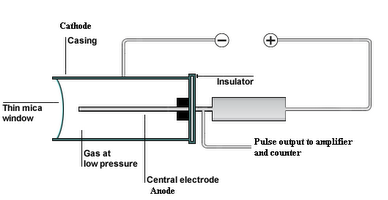Nuclear radiation can be detected and identified with a Geiger Muller tube. The radiation enters through a thin glass window into a gas chamber containing low pressure gas and a thin positive electrode which creates an intense electric field, and a negative case.
When nuclear radiation - either alpha, beta or gamma - enters the chamber, collisions with the gas molecules create ions which are accelerated in the electric field. Negative ions are attracted to the positive electrode and positive ions are attracted to the negative case. The ions collide with the gas molecules, and a cascade effect caused by repeated collisions and accelerations produces a current pulse.

The Geiger Muller tube can be connected to a counter or rate meter to count the total number of radioactive particles or the number of radioactive particles entering per second.
